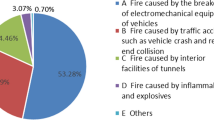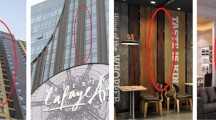Abstract
In this study, a series of sidewall fire experiments were carried out in an arched tunnel, and the effect brought by the fire source height, the shape and the orientation of oil pool on flame length and transverse temperature were investigated. The results show that when the long side of oil pool is parallel to sidewall, the height change of oil pool has less influence on flame under the arched ceiling, while it has a large influence under the horizontal ceiling in previous studies; when the long side of oil pool is perpendicular to sidewall, the flame bifurcates with a large aspect ratio and entrains more fresh air, and the mass loss rate increases dramatically. The height change of oil pool has less influence on the flame when the long side of oil pool is parallel to sidewall, while it has great influence when the long side of oil pool is perpendicular to sidewall. Besides, the dimensionless heat release rates of fire source are modified and the flame length formulas are obtained under the two orientations of oil pool. The equation of the transverse temperature distribution under arched ceiling was obtained by modifying the lateral travelling distance of the plume.












Similar content being viewed by others
Abbreviations
- \(r_{l}\) :
-
Longitudinal flame length under ceiling (m)
- \(r_{t}\) :
-
Transverse flame length under ceiling (m)
- D p :
-
Equivalent diameter considering pool shape (m)
- \(Q_{{D_{p} }}^{*}\) :
-
Modified dimensionless heat release rate by Fan
- \(H_{ef}\) :
-
Effective height of the fire source to the ceiling (m)
- \(Q_{{l_{p} H_{ef} }}^{*}\) :
-
Modified dimensionless heat release rate by Ji
- L :
-
Total flame length (m)
- n :
-
Aspect ratio (the ratio of the long side to the short side)
- S :
-
Pool area (m2)
- H :
-
Height from the ground to the bottom of the pool (m)
- A :
-
Length of the long side of pool (m)
- B :
-
Length of the short side of pool (m)
- \(\dot{m}\) :
-
Mass loss rate of unburnt fuel before impingement (kg/s)
- \(\dot{m}_{up}\) :
-
Mass loss rate of unburnt fuel in upward direction after impingement (kg/s)
- \(\dot{m}_{down}\) :
-
Mass loss rate of unburnt fuel in downward direction after impingement (kg/s)
- \(\dot{m}_{leng}\) :
-
Mass loss rate of unburnt fuel in lengthwise direction after impingement (kg/s)
- \(\dot{m}_{loss}\) :
-
Mass loss rate (kg/s)
- \(\alpha\) :
-
Tangent angle at the flame impact point (°)
- \(\dot{m}^{\prime\prime}_{\infty }\) :
-
Asymptotic value for fuel mass loss rate per unit area (kg/(s m2))
- D :
-
Equivalent diameter (m)
- \(Y_{ox,l}\) :
-
Oxygen fraction feeding flame
- \(Y_{ox,o}\) :
-
Oxygen fraction in free burning
- \(\dot{q}^{\prime\prime}_{Ext}\) :
-
External heat feedback per area from environmental (kW/m2)
- \(L_{g}\) :
-
Heat of gasification (kJ/kg)
- a, b :
-
Constants
- \(\dot{m}_{e}\) :
-
Mass flow rate of entrainment (kg/s)
- \(Y_{{O_{2} ,\infty }}\) :
-
Mass fraction of oxygen in environment
- w :
-
Constant
- \(u_{e}\) :
-
Speed of entrainment (m/s)
- p :
-
Circumference of oil pool that can entrain (m)
- \(\dot{Q}\) :
-
Heat release rate (kW)
- \(c_{p}\) :
-
Specific heat of ambient air (kJ/(kg k))
- \(T_{a}\) :
-
Temperature of ambient air (°C)
- g :
-
Gravity acceleration (m/s2)
- \(l_{p}\) :
-
Length of pool side which is perpendicular to sidewall (m)
- \(Q_{{D_{p} H_{ef} }}^{*}\) :
-
New modified dimensionless heat release rate
- \(\Delta T\) :
-
Temperature rise (°C)
- d :
-
Transverse distance under the horizontal ceiling (m)
- l :
-
Arc length of plume travelling along arched ceiling (m)
- R :
-
Radius of the arched ceiling (m)
- \(\theta\) :
-
Central angle (°)
- \(\alpha\) :
-
Inclined angle (°)
- \(\rho_{a}\) :
-
Density of ambient air (kg/m3)
- \(\gamma\) :
-
Stoichiometric ratio
References
Ji J, Fan CG, Li YZ, Ingason H, Sun JH (2015) Experimental study of non-monotonous sidewall effect on flame characteristics and burning rate of n-heptane pool fires. Fuel 145:228–233
Gao ZH, Ji J, Wan HX, Li KY, Sun JH (2015) An investigation of the detailed flame shape and flame length under the ceiling of a channel. Proc Combust Inst 35(3):2657–2664
Hasemi Y, Nishihata M (1989) Fuel shape effect on the deterministic properties of turbulent diffusion flames. Bull JPN Assn Fire Sci Eng 38(2):29–34
Ji J, Tan TT, Gao ZH, Wan HX (2019) Influence of sidewall and aspect ratio on burning behaviors of rectangular ethanol and heptane pool fires. Fuel 238:166–172
Fan CG, Ji J, Li YZ, Ingason H, Sun JH (2017) Experimental study of sidewall effect on flame characteristics of heptane pool fires with different aspect ratios and orientations in a channel. Proc Combust Inst 36(2):3121–3129
Liu X, Zhu GQ, Pan RL, Xu G, He L (2021) Experimental study on wall fire behavior produced by n-heptane pools with different aspect ratios and orientations in arched tunnel. Case Stud Therm Eng 28:101438
Pan RL, Zhu GQ, Liang ZH, Zhang GW, Liu HN, Zhou X (2020) Experimental study on the fire shape and maximum temperature beneath ceiling centerline in utility tunnel under the effect of curved sidewall. Tunn Undergr Sp Technol 99:203304
Pan RL, Zhu GQ, Xu G, Liu X (2021) Experimental analysis on burning rate and temperature profile produced by pool fire in a curved tunnel as a function of fire location. Process Saf Environ 152:549–567
Pan RL, Hostikka S, Zhu GQ, Xu G, Liu X (2022) Two-dimensional analysis on ceiling jet temperature characteristics in a semicircular tunnel. Fire Technol 58:959–990
Ji J, Fu YY, Li KY, Sun JH, Fan CG, Shi WX (2015) Experimental study on behavior of sidewall fires at varying height in a corridor-like structure. Proc Combust Inst 35(3):2639–2646
Tang F, Zhu YT, Chen L, Sun XP, McNamee M, Hees PV, Hu LH (2020) Experimental study and analysis of radiation heat fluxes received by a floor beneath an inclined ceiling. Fire Mater 45(2):205–214
Utiskul Y, Quintiere J (2008) An application of mass loss rate model with fuel response effects in fully-developed compartment fires. Fire Saf Sci 9:827–838
Zhang XC, Tao HW, Xu WB, Liu XZ, Li XD, Zhang XL (2017) Flame extension lengths beneath an inclined ceiling induced by rectangular-source fires. Combust Flame 176:349–357
Pan RL, Zhu GQ, Xu G, Liu X (2022) Experimental and theoretical analysis on extension flame length of buoyancy-induced fire plume beneath the curved ceiling. Tunn Undergr Space Technol 122:104365
Yan WG, Wang CJ, Guo J (2012) One extended OTSU flame image recognition method using RGBL and stripe segmentation. Appl Mech Mater 121:2141–2145
Zukoski EE, Cetegen BM, Kubota T (1985) Visible structure of buoyant diffusion flames. Symp Int Combust 20(1):361–366
An W (2015) Investigation of combustion and flame spread behaviors of PS insulation materials applying to building exterior wall. University of Science and Technology of China, Beijing
You HZ, Faeth GM (1981) An investigation of fire impingement on a horizontal ceiling. Penn State University, Pennsylvania
Gao ZH, Ji J, Wan HX, Zhu JP, Sun JH (2017) Experimental investigation on transverse ceiling flame length and temperature distribution of sidewall confined tunnel fire. Fire Saf J 91:371–379
Kung HC, Spaulding RD, Stavrianidis P (1991) Fire induced flow under a sloped ceiling. Fire Saf Sci 3:271–280
Oka Y, Imazeki O, Sugawa O (2010) Temperature profile of ceiling jet flow along an inclined unconfined ceiling. Fire Saf J 45(4):221–227
Acknowledgements
The work was supported by the National Key Research and Development Program of China (No. 2016YFC0802900).
Author information
Authors and Affiliations
Corresponding author
Additional information
Publisher's Note
Springer Nature remains neutral with regard to jurisdictional claims in published maps and institutional affiliations.
Rights and permissions
Springer Nature or its licensor (e.g. a society or other partner) holds exclusive rights to this article under a publishing agreement with the author(s) or other rightsholder(s); author self-archiving of the accepted manuscript version of this article is solely governed by the terms of such publishing agreement and applicable law.
About this article
Cite this article
Liu, X., Zhu, G., Pan, R. et al. Experimental Study on Flame Length of Sidewall Fire with Different Aspect Ratios and Orientations in an Arched Tunnel. Fire Technol 58, 3577–3596 (2022). https://doi.org/10.1007/s10694-022-01328-w
Received:
Accepted:
Published:
Issue Date:
DOI: https://doi.org/10.1007/s10694-022-01328-w




